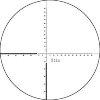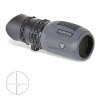Hmmm, no one mentioned the Sheppard scopes or the Letherwood ART. I played ONCE with an ART and it seemed a good for military use.
The Sheppard Scopes were fixed power and had a set of rings of progressively smaller size on the verticle cross hair. Each ring subtensed 18 inches at a given range and the scopes were set up for a specific caliber and load. Choose the circle that fit and 18 inch target and the range was on for that rifle and scope.
The ART on the NM M14 and "M21" system used stadia lines on each leg of the cross hair. Verticle lines were 18 inches and horizontal lines were 36 inches at a given range One adjusted the power of the 3x9 scope until the target of that size fit between the lines and the "Auto Ranging cam and levers adjusted the elevation to deal with that range. WHen it was broken and no longer "Auto Ranged" One still found the range by adjusting the power and simply reading the power setting as hundreds of meters to 900 meters.
Now military shooting can have some known sized objects to help stadia range finders such as mil dots work better. Given various trucks and armored vehicles as targets I did some fairly accurate range finding with military binocs to 3000 meters. Now by that I mean to with in 35 meters at 1600 meters whish means 155mm gun howitzer frags WILL fly about and on the target if the guys doing the math at the guns do their job right.
I found US military maps to be excellent "Range Finders" though a hunter would consider them sloppy. They mainly helped in establishing a range card. If I know a ridge line is 800 meters away and the horse shoe bend creek at the bottom of the hill I am on 550 meters away then I know things between those to points immediately to be more than 550 and less than 800 meters. Now I have something to guestimate with or what we called SWAG for "Scientific Wild A## Guess" Gosh that big old rock is about half way between creek and ridge best I can tell, so its at maybe 675 meters and the target is less than a third of the way to the ridge from there so call it maybe 40 more meters and figure my fire mission for 715 meters in that direction or set up the M60 GPMG or M2HB and hope the gunner properly zeroed the sights and set them for 700 and let fly. Anytime we stopped for more than three or four minutes a new range card got started. Figuring out where we were was constant.
Now the kids have alsort of electronic gadgetry, but not that long ago one of the jobs of a Cannon Batter XO was to know were he was ALL THE TIME even driving down a road way. We were expected to do what was called a "Hip Shoot" A priority fire mission might come in while a battery is "Displacing" that is moving from one planned firing position to another. If Division Artillery decided the priority was high enough a battery in transit simply pulled off the road and pointed in an assigned direction, initially with e XO simply pointing for the base gun to point in the general direction. He then walked behind each gun as they backed onto their spades and opened the rear doors and used a hand held compass to give direction by looking along or through the tube. This right away is going to mean ragged sheathes ( the impacts will not be on line a school pretty) but he has to know where he IS. He has to trust his battery to look out for threats while he constantly keeps track of where he is......as in the jeep stops and right then he needs to be able to say where he is within 300 meters and over the next minute or so while he is giving the guns direction he has to figure out the position of the base piece to "PDC" (pretty darned close.)
Now "survey standard" is direction to within two mils and position to within two meters and that ain't going to happen. Still with in a minute or two of stopping location will be correct to with in generally 25 to 50 meters, with a US GI map, a hand held compass and a M1 Brain.
If you are hunting over a specific area repeatedly and an area that range matters it should not be hard to build range cards for several way points in that area. This is why we trained in the same "battle areas" in Europe in the seventies that we expected to fight in. The village of Schlitz (no really it is where the family came from) and its two steeples and big water tank on the hill over the village are not going anywhere. Where the dirt road north from that horrible garden gnome collection lived was in the same spot everytime I saw it. The survey bench marker near the cut in the old road did not get up and wander around and I knew it to be 120 metes due west of the cut.
Knowing where you are and where know objects are greatly increases your ability to tell where "new" targets amongst all that are and therefore the range from you to them.
I like firearms from 4mm zimmer shutzen to 8 inch howitzers, but honestly a good set of maps and decent reliable compass are about as important in the field for military ops for pre GPS days.......and a few bucket loads of BBs dropped into certain orbital patterns or some advance Electronic Warfare might make those skills just as valuable today.
BTW the US and NATO decided to round up "mils" on their equipment to be 6400 mils in a circle (easier work with than 6283. whatever) while the Soviets and Chinese went with rounding down to 6000. Something to know if you are buying some of the neat surplus out there these days. Some soviet guns had built in mechanical "Computers" The D30 122mm towed had a cone shaped drum that one set up to the desired range from the gun rather than elevating to a specific angle in mils and the gun had an adjust able azmith ring set up for their 6000 mil system so a gun crew knowing only the range and direction of a target from their position could lay and fire with out a third party figuring firing data. Not as accurate as us but pretty darned quick and pretty darned good. Wholly mechanical.
KISS......Keep It Simple, Stupid
-kBob





